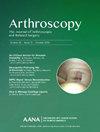Evolution of the Surgical Treatment of Ulnar Collateral Ligament Injuries
IF 4.4
1区 医学
Q1 ORTHOPEDICS
Arthroscopy-The Journal of Arthroscopic and Related Surgery
Pub Date : 2024-11-12
DOI:10.1016/j.arthro.2024.09.001
引用次数: 0
Abstract
Since Dr. Frank Jobe performed the initial surgery on Tommy John in 1974, the ulnar collateral ligament (UCL) reconstruction (UCLR), colloquially “Tommy John Surgery,” described in 1986 has evolved as the gold standard treatment for UCL tears. The crux of technique modifications involve flexor pronator mass (FPM) management, ulnar nerve transposition (UNT), graft selection, or graft-fixation options. Jobe used a figure-of-8 graft fixation through the cubital tunnel, necessitating FPM elevation and UNT. Although 68% of patients returned to play (RTP), 25% of patients experienced ulnar neuritis, prompting change. Described by Thompson et al. in 2001, the modified Jobe technique implemented a muscle-splitting approach to the FPM, eliminating the need for FPM elevation, facilitating optional UNT. This technique uses larger tunnel sizes to facilitate graft passage in a figure-of-8 fashion. Graft selection is another consideration in UCLR. Most commonly, the palmaris longus autograft is used. In addition, there are no significant outcome differences between alternative graft types such as allografts, hamstring autografts, or extensor tendons. Notably, palmaris longus autograft is perhaps a high-risk choice, given the proximity to the median nerve. One case series reported 19 incidents of iatrogenic median nerve harvest. Lastly, the docking technique, from Altchek et al. in 2002, builds upon the modified Jobe. Using the FPM split, optional UNT enhanced graft passage and fixation with one humeral tunnel and smaller exit holes. This approach demonstrates a remarkable 90% RTP at 12 to 18 months, ultimately leading to satisfactory outcomes and potentially shorter operating room times. An alternative approach to UCLR, UCL repair with suture augmentation obviates the need for a graft, shortening RTP time to approximately 6 months. Historically, UCL repair indications were inconsistent; however, the current professional consensus suggests acute injuries, minimal ligamentous degeneration, or isolated proximal or distal avulsions may be optimal injury patterns for repair.
手术治疗尺侧副韧带损伤的演变。
自弗兰克-乔布医生于 1974 年为汤米-约翰实施首次手术以来,1986 年描述的尺侧韧带重建术(UCLR)(俗称 "汤米-约翰手术")已发展成为治疗尺侧韧带撕裂的金标准疗法。技术改造的核心涉及屈指前伸肌群(FPM)管理、尺神经转位(UNT)、移植物选择或移植物固定选择。乔布使用的是通过肘隧道的 "8 "字形移植物固定,因此必须抬高FPM并进行尺神经转位。虽然 68% 的患者重返赛场 (RTP),但 25% 的患者出现尺神经炎,这促使他们做出改变。汤普森等人在 2001 年描述了改良的乔布技术,该技术对 FPM 采用肌肉分割方法,无需抬高 FPM,从而方便了可选的 UNT。该技术采用更大的隧道尺寸,以 "8 "字形方式促进移植物通过。移植物的选择是 UCLR 的另一个考虑因素。最常用的是掌长肌自体移植物。此外,异体移植物、腘绳肌自体移植物或伸肌腱等其他类型的移植物在效果上没有明显差异。值得注意的是,由于掌长肌自体移植物靠近正中神经,因此可能是一种高风险的选择。一个病例系列报告了19例正中神经切取的先天性事故。最后,Altchek 等人在 2002 年提出的对接技术以改良的 Jobe 为基础。通过使用 FPM 分割,可选的 UNT 通过一个肱骨隧道和较小的出口孔增强了移植物的通过性和固定性。这种方法在 12 至 18 个月内的 RTP 率高达 90%,最终取得了令人满意的结果,并可能缩短手术室时间。作为 UCLR 的另一种方法,UCL 修复缝合增强术无需移植物,可将 RTP 时间缩短至约 6 个月。从历史上看,UCL修复术的适应症并不一致;但目前的专业共识表明,急性损伤、韧带退化程度轻微或孤立的近端或远端撕脱可能是最佳的修复损伤模式。
本文章由计算机程序翻译,如有差异,请以英文原文为准。
求助全文
约1分钟内获得全文
求助全文
来源期刊
CiteScore
9.30
自引率
17.00%
发文量
555
审稿时长
58 days
期刊介绍:
Nowhere is minimally invasive surgery explained better than in Arthroscopy, the leading peer-reviewed journal in the field. Every issue enables you to put into perspective the usefulness of the various emerging arthroscopic techniques. The advantages and disadvantages of these methods -- along with their applications in various situations -- are discussed in relation to their efficiency, efficacy and cost benefit. As a special incentive, paid subscribers also receive access to the journal expanded website.

 求助内容:
求助内容: 应助结果提醒方式:
应助结果提醒方式:


